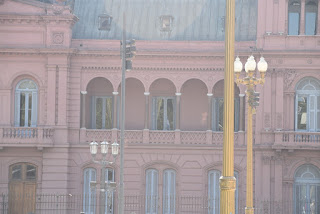Our first stop was Plaza de Mayo located at the spot where the city was founded. On the way we passed the Colon Theater which has been recognized as the third best opera house in the world.
Since the revolution of May 25, 1810 that led to Argentine's independence, this city square with the Casa Rosada presidential palace has played a pivotal role in the politics of Buenos Aires. On this balcony, Juan and Eva Peron addressed the crowds. Opinions of the Perons are varied - he was a dictator but she is known for her support for the working classes.
Facing the plaza is the cathedral where the current pope, Francis, was bishop.

The floor of the cathedral is inlaid with mosaic depicting the passion flower - representing the Passion of Christ.
In the centre of the plaza is an obelisk erected in 1811 to celebrate Argentina's independence from Spain. The white stones inlaid in the walkway represent the white scarves worn by women protesters following the military coup of 1976. At that time many dissenters simply disappeared.
Our next stop was the historic neighbourhood of La Boca. The multi-coloured houses, street vendors, and tango cafes give a European flavour to the street scene. On the way to our next stop we saw the Floralis Generica the United Nations Park. This steel and aluminum sculpture in a reflecting pool opens in the morning and closes in the evening.
Our final stop was Recoleta Cemetery containing 6400 architecturally diverse mausoleums. There we visited the black marble crypt of Eva "Evita" Peron.






No comments:
Post a Comment